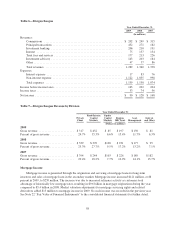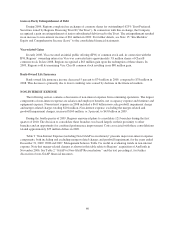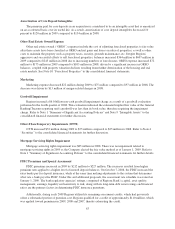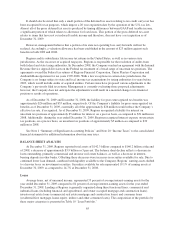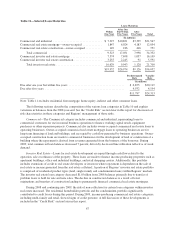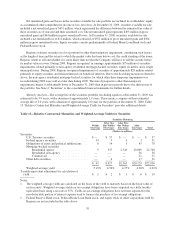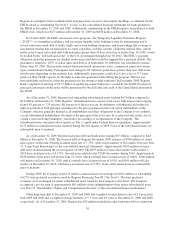Regions Bank 2009 Annual Report Download - page 82
Download and view the complete annual report
Please find page 82 of the 2009 Regions Bank annual report below. You can navigate through the pages in the report by either clicking on the pages listed below, or by using the keyword search tool below to find specific information within the annual report.Residential First Mortgage—Residential first mortgage loans represent loans to consumers to finance a
residence. These loans are typically financed over a 15 to 30 year term and, in most cases, are extended to
borrowers to finance their primary residence. These loans experienced a $207 million decline to $15.6 billion in
2009. Demand for this type of lending slowed during 2008 as property values declined, new and used home sales
reached historically low levels, and credit markets contracted in general. Higher charge-offs also contributed to
declines in this category. However, due to declining mortgage rates, which became especially attractive late in
2008 and throughout 2009, refinancing activity increased substantially in 2009, and partially offset the decline.
See the “Credit Risk” section later in this report for additional discussion.
Home Equity—Home equity lending includes both home equity loans and lines of credit. This type of
lending, which is secured by a first or second mortgage on the borrower’s residence, allows customers to borrow
against the equity in their home. Real estate market values as of the time the loan or line is secured directly affect
the amount of credit extended and, in addition, changes in these values impact the depth of potential losses. The
vast majority of Regions’ home equity lending balances was originated through its branch network. During 2009,
home equity balances decreased $749 million to $15.4 billion, driven by a general decline in demand and lower
property valuations across the Company’s operating footprint. During 2009, credit quality within the home equity
portfolio continued to reflect pressure. Accordingly, higher charge-offs also contributed to declines in this
category. The majority of the credit losses from this portfolio are related to loans where the collateral is a second
lien located in Florida. A full discussion of these developments is included in the “Credit Risk” section later in
this report.
Indirect—Indirect lending, which is lending initiated through third-party business partners, is largely
comprised of loans made through automotive dealerships. Regions continually rationalizes the risk/reward
characteristics of each of its lending lines and ceased new originations within the indirect auto lending business
in 2008 and the marine and recreational vehicle lending businesses in 2007, resulting in a decrease of $1.4 billion
or 36% in 2009. Each of these portfolios is a declining element in the overall loan portfolio and will continue to
reduce as loans are repaid.
Other Consumer—Other consumer loans include direct consumer installment loans, overdrafts and other
revolving credit, and educational loans. Other consumer loans totaled $1.2 billion at December 31, 2009,
relatively unchanged from prior year.
Loans Held for Sale
At December 31, 2009, loans held for sale totaled $1.5 billion, consisting of $316 million of non-performing
investor real estate loans, $783 million of residential real estate mortgage loans, and $412 million of student
loans. At December 31, 2008, loans held for sale totaled $1.3 billion, consisting of $420 million of
non-performing investor real estate loans, $513 million of residential real estate mortgage loans, and $349
million of student loans. The increase in loans held for sale primarily resulted from increased mortgage
origination volumes and from loans being designated as held for sale during the year, partially offset by sales
activity.
Allowance for Credit Losses
The allowance for credit losses represents management’s estimate of credit losses inherent in both the loan
portfolio and unfunded credit commitments as of the balance sheet date. The allowance consists of two
components: the allowance for loans losses, which is recorded as a contra-asset to loans, and the reserve for
unfunded credit commitments, which is recorded in other liabilities. At December 31, 2009, the allowance for
credit losses totaled $3.2 billion or 3.52 percent of loans, net of unearned income, compared to $1.9 billion or
1.95 percent at year-end 2008. See “Allowance for Credit Losses” in the “Risk Management” section found later
in this report for a detailed discussion of the allowance.
68


